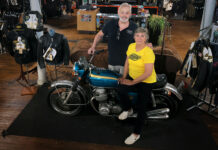MIC/SVIA INDUSTRY RESPONSE TO CPSC REJECTION OF LEAD STANDARD EXCLUSION PETITION AND PROPOSED STAY OF ENFORCEMENT IRVINE, Calif., April 17, 2009 — The Motorcycle Industry Council (MIC) and the Specialty Vehicle Institute of America (SVIA) are disappointed that the Consumer Product Safety Commission (CPSC) announced that they intend vote today to reject the petition that our industry submitted for an exclusion for all-terrain vehicles (ATVs), and motorcycles from the lead content limits found in the Consumer Product Safety Improvement Act (CPSIA). Both Commissioners have proposed a stay of enforcement, acknowledging that the current ban on youth model ATVs and motorcycles means larger and faster adult-size vehicles become likely alternatives for children 12 years of age and younger that as Acting Chairman Nord stated, “increas[e] their risk of injury or death.” Commissioner Moore stated, “There are compelling safety arguments that justify a stay of enforcement.” “While we are pleased that both Commissioners recognize the importance of ending the ban on youth model vehicles, we need to review the actual text of the proposed stay,” said Paul Vitrano, general counsel for the MIC and SVIA. It is also important to note that, even if a stay of enforcement can be implemented by the CPSC, this is not a solution and would only be a temporary reprieve as to the agency’s enforcement of the ban. It would not apply to state Attorney Generals or address other unintended consequences of the lead ban. “With today’s vote, it is now obvious that the only permanent solution is for Congress to end the ban once and for all by amending the Consumer Product Safety Improvement Act (CPSIA) so parents once again have access to appropriate-sized youth model ATVs and motorcycles for their children,” said Paul Vitrano. Since 1983, the Specialty Vehicle Institute of America® has promoted the safe and responsible use of All-Terrain Vehicles through rider training programs, public awareness campaigns, and state legislation. The SVIA also serves as a resource for ATV research, statistics, and vehicle standards. The SVIA, based in Irvine, Calif., is a not-for-profit trade association sponsored by Arctic Cat, BRP, Honda, Kawasaki, KTM, KYMCO, Polaris, Suzuki, Tomberlin, Tomoto and Yamaha. The Motorcycle Industry Council is a not-for-profit, national trade association representing manufacturers and distributors of motorcycles, scooters, motorcycle/ATV/ROV parts and accessories, and members of allied trades such as publishing companies, advertising agencies, insurance firms and consultants. The MIC is headquartered in Irvine, Calif., with a government relations office adjacent to Washington, D.C. The organization has been in operation since 1914. More, from a press release issued by AMA: CPSC poised to delay enforcement of law that bans sale of youth-model motorcycles and ATVs PICKERINGTON, Ohio –The Consumer Product Safety Commission (CPSC) has voted to deny a petition to exclude youth-model motorcycles and ATVs from a law that bans their sale because of possible lead concerns–but has cleared the way for a second vote by month’s end to delay enforcement of the law, the American Motorcyclist Association (AMA) reports. Because both members of the commission have said they favor a stay of enforcement, the move almost certainly will stay the execution of parts of the Consumer Product Safety Improvement Act (CPSIA) within the agency. On Friday, commission filings in preparation for the vote indicated a stay could be as long as two years, possibly expiring May 1, 2011. A planned second vote on that timeframe was expected by the end of April. In addition, it’s not clear whether state attorneys general, who are also charged with enforcing the law, will also stand down. “Clearly this latest move shows that the CPSC realizes that youth-model motorcycles and ATVs have no business getting caught up in a law aimed at children’s toys,” said Ed Moreland, the AMA’s vice president for government relations. “We’re heartened that both commissioners favor a stay of enforcement, and it appears that this could clear the way for dealers to sell youth-model motorcycles and ATVs–an important consideration for riders and motorsports businesses alike as the riding and racing season ramps up. “However, this vote doesn’t solve the larger, long-term issue, which is whether or not youth-model motorcycles and ATVs will be exempted from the CPSIA,” Moreland noted. “We believe they should be excluded, and we will continue to work with our partners in the industry and our friends in Congress to make that happen.” Acting CPSC Chairwoman Nancy Nord went on record on April 3 favoring a stay of enforcement. On April 16, Commissioner Thomas Moore agreed. “It is clear from the post-enactment statements of some Members of Congress who were Conferees on the CPSIA that they believe the Commission has the authority to make sensible allowances for these vehicles as long as child safety is not compromised,” Moore said in his statement. “Given the extremely restrictive language of the law, the only avenue I can see is for the Commission to establish an enforcement plan that follows, to the greatest extent possible, the Act’s intention for future production, while providing relief to the industry and the riding community for vehicles already manufactured and those manufactured during the stay.” The full text of Moore’s statement is below. STATEMENT OF THE HONORABLE THOMAS H. MOORE ON THE PETITION FOR TEMPORARY FINAL RULE TO EXCLUDE A CLASS OF MATERIALS UNDER SECTION 101(b) OF THE CONSUMER PRODUCT SAFETY IMPROVEMENT ACT OF 2008 (CPSIA) April 16, 2009 I am aware of the speculation that has surrounded my vote on this issue. My staff has spent the time since the ballot came to the Commission working on what I believe is a good solution for the riders of youth motorized recreational vehicles, building and expanding upon the initial position taken by Acting Chairman Nord. The direction my colleague and I are giving to the staff today balances the Congressional desire to protect children from unnecessary contact with leaded components in these vehicles with the need to protect those same children from the potential for physical injury related to riding inappropriate adult-sized vehicles, or riding vehicles either in need of repair or less structurally sound than the ones currently on the market. It is clear from the post-enactment statements of some Members of Congress who were Conferees on the CPSIA that they believe the Commission has the authority to make sensible allowances for these vehicles as long as child safety is not compromised. Given the extremely restrictive language of the law, the only avenue I can see is for the Commission to establish an enforcement plan that follows, to the greatest extent possible, the Act’s intention for future production, while providing relief to the industry and the riding community for vehicles already manufactured and those manufactured during the stay. There are compelling safety arguments that justify a stay of enforcement. It is ironic that I am defending vehicles that I consider to be dangerous for children under 12 to ride and which contain accessible parts with excess levels of lead. However, the alternatives appear to be more dangerous. American parents seem to be willing to accept the risk for their children riding these vehicles, so it is the agency’s task, at this stage, to ensure that the vehicles are as safe as possible. One safety rule the agency has stressed is keeping children off of adult-sized ATVs.1 To the extent that new children’s ATVs cannot currently meet the lead limits in the CPSIA, there is the likelihood that parents seeking new vehicles will buy adult-sized ATVs for their children to use. We have also been notified by one ATV manufacturer that they are simply relabeling their Y-6+ and Y-10+ youth ATVs as Y-12+, removing the speed limiting device and continuing to sell them. Thus the vehicles that are more accurately sized for younger children will be less safe because of their ability to attain higher speeds. The other part of the safety equation that helps balance an enforcement plan against the increased lead exposure it allows, is based on the assertions that certain vehicle components cannot be made with lead below a certain level without compromising the structural integrity (or another safety element) of the component. The enforcement plan of the Commission must require concrete data from the manufacturers on this point to justify their continued use of lead in excess of the applicable lead limit. The industry has pointed to the European Union’s RoHS and ELV Directives as a guide for what lead reductions or substitutions may be technologically infeasible for their youth vehicles. While we might not need to allow the high lead limits allowed in those Directives for all components, there is guidance to be taken in how the European system is administered. They set an expiration date for their exemptions. Prior to that expiration date it is up to industry to come in and make their case that it is still technologically infeasible to reduce lead to a level at which an exemption is no longer required. The evidence considered is strictly limited to technological feasibility, not on the higher cost of a viable substitute. The guiding principle for this agency’s determinations has to be the safety of the children riding these vehicles. I believe a stay of enforcement issued by the Commission should: –relieve all makers, sellers, and distributors of youth motorized recreational vehicles made to date and through the expiration date of the stay from enforcement actions for failure to meet the lead limits of the CPSIA; –allow those vehicles to be repaired, sold, traded, and otherwise used as they have been; –allow the sale, distribution and installation of replacement parts that are comparable in lead levels to the old part being replaced until such time as those parts can be brought into compliance; –expect industry to bring their vehicle components into compliance on a reasonable schedule, to the extent that is technologically feasible, and to provide us with the detailed information we need to make informed decisions about those components in the future. The Commission simply cannot ignore the safety tradeoffs that could arise by not providing this relief but it must also work with industry to bring the non-complying components of these youth vehicles as close to the lead limits established by law as is currently technologically feasible, to the extent those parts cannot be made inaccessible. The Commission also needs to let the riding community know that they can continue to use the vehicles they own as they always have. I believe the approach taken today by myself and Acting Chairman Nord of directing the staff to draft a Federal Register notice containing concrete elements of a stay is the reasonable approach that the Congress is looking for us to take. I anticipate that the Commission will vote to approve it in the near future. 1) Most of my discussion is focused on the ATV industry as they present the greatest (lead and non-lead) safety challenges. However, the enforcement program will also apply to children’s off-road motorcycles and snowmobiles. About the American Motorcyclist Association Since 1924, the AMA has promoted and protected the motorcycling lifestyle. AMA members come from all walks of life and they navigate many different routes on their journey to the same destination: freedom on two wheels. As the world’s largest motorcycle organization with nearly 300,000 members, the AMA advocates for motorcyclists’ interests in the halls of local, state and federal government, the committees of international governing organizations and the court of public opinion. Through member clubs, promoters and partners, the AMA sanctions more motorsports competition events than any other organization in the world. Through its Motorcycle Hall of Fame Museum, the AMA preserves the heritage of motorcycling for future generations. For more information, visit www.AmericanMotorcyclist.com.
Updated: More On Lead-Based Ban Of Kids’ Dirt Bikes And ATVs
Updated: More On Lead-Based Ban Of Kids’ Dirt Bikes And ATVs
© 2009, Roadracing World Publishing, Inc.






